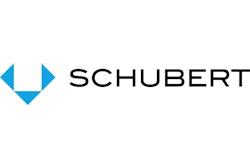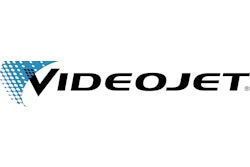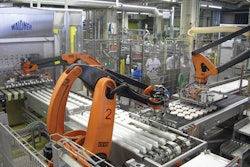Fürth, Germany-based Trolli GmbH, a part of the Mederer group of companies, produces sweets such as gummi candies, marshmallows, and soft licorice gums. Since the 1980s, one of the company’s most well-known products has been the Trolli Burger, a gummi candy made of several layers of fruit gum and sugar foam created to look like a hamburger on a bun. In May 2013, Trolli began operation of a new packaging line from Gerhard Schubert GmbH to automatically assemble and package a smaller version of the product—the Trolli Mini Burger—at 540/min.
Loosely stacked in a hinged plastic tray, the three parts of the Trolli Mini Burger—the “bun,” the “cheese and lettuce,” and the “burger and bun”—are organized in a set order and orientation. To accomplish the required speed of 540/min, 1,620 individual candy pieces must be assembled into the plastic trays. Schubert has achieved this level of output with its TLM-F44 packaging line. In this case, the line comprises 17 submachines and features 18 TLM-F4 four-axis pick-and-place robots as well as a number of two-axis TLM-F2 robots.
The packaging line integrates two Transmodule sections, one of which is a 30-m rail section—the longest implemented by Schubert so far. The patented TLM Transmodule is a single-axis, rail-based robot with contactless energy and data transmission. A turning unit is located at each end of the rail section that enables unloaded modules to travel back to the other end on the lower track. On Trolli’s 30-m rail section, 30 Transmodules transport the trays to the picking area and then on to the closing station. The second rail section carries the closed trays to an ultrasonic sealer.
Individual Transmodules move autonomously, with a Transmodule moving cyclically to set down a tray. Multiple Transmodules then group together and act as a continuous chain conveyor for the pick-and-place process. Once the trays are filled, the individual Transmodules separate and transition back to a cyclical motion for removal of the trays. The result is high flexibility in a small space.
The first two submachines each contain a multi-lane magazine with plastic trays. The associated TLM-F3—a robot equipped with a suction or gripper tool designed specifically to remove materials from a magazine—removes trays and transfers them to a TLM-F2 robot, which places them into the tool of a Transmodule. The tool takes two rows of 12 cups each.
The Transmodules then move to the picker stations as a group, where the first three product belts feed the bottom piece of the Trolli Mini Burger. This is followed by three product belts each for the middle and top pieces. The feeders are arranged crosswise to the line.
Scanners record the position, rotary orientation, and bottom or top surface of the fruit gums. TLM-F4 robots pick up the products. If the correct side is facing up, the robot places the product directly into one half of the plastic tray. If a burger element has to be turned, the product enters a turning unit immediately next to the product belt. Once the element is turned, it can be removed by the picking robot.
The fruit-gum burger is complete at the end of the picker line, where the bottom and middle pieces are in one half of the tray, and the top piece is in the other half. The Transmodule then moves the trays to the closing station. There, a TLM-F2 robot removes a row of plastic trays and places them onto a table, where they are automatically closed. Another TLM-F2 robot then removes the packages and places them onto their sides into a size plate of a Transmodule on the second rail section. The compartments of the tool hold the plastic tray closed.
During further transversal, each individual plastic tray receives a label from a Pago labeling system and is then printed with a batch number using a Wolke coder from Videojet. The code is then inspected by a Cognex camera system.
Closed, labeled trays are then removed from the size plate and are transferred to the sealing unit. To seal the trays, Trolli uses an ultrasonic system that provides a reliable seal, while ensuring ease of opening for consumers, despite the tray’s small tab. After sealing, a two-axis robot grips the packages and places them onto the discharge belt. The finished products then run through a checkweigher, followed by a metal detector.
Trolli CEO Herbert Mederer appreciates the high degree of flexibility afforded by TLM technology. A larger version of the Trolli Mini Burger and a Trolli Pizza have also been assembled and packaged on the new TLM line. “The Schubert line is accompanying our growth and gives us freedom to innovate,” he says. “We’re planning on making additional investments overseas.”
Learn more about Schubert’s packaging systems.
This article is part of the August 2014 Robotics & Automation Special Report. See the full report here.






























